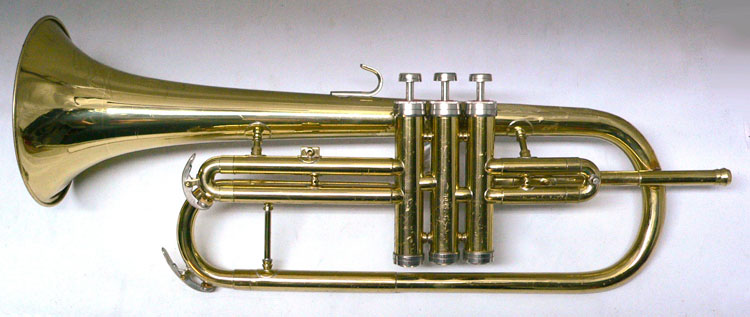Conn 20A Flügelhorn

Date: 1969. Owned by Christine Derksen
This is the only flügelhorn in production by Conn during this period. Perhaps that is the reason it is listed as an "A" model: cornet. It isn't a cornet of course, but I guess a cornet would be the closest "relative". Notice that this flügelhorn has the main tuning slide approximately in the position you would expect it to be in a trumpet. This is odd, since every single (modern) flügelhorn I have seen has the main tuning slide in the mouthpiece receiver (essentially lengthening the leadpipe). Putting it in the mouthpiece receiver makes sense from the point of view that having it where it is in this model requires a section of cylindrical tubing; the fluegelhorn is by definition a very conical instrument. The 20A was in production between about 1963 and 1969. I strongly suspect it didn't last much beyond 1969, since a different model flügelhorn was produced during the 1970's. The same model 20A was also produced from 1927 to 1940. See separate entry.
The bore size of the 20A is 0.422", which is a #½. It is designed to use a cornet mouthpiece; a flugelhorn mouthpiece is too large. Cornet mouthpieces have a slightly narrower shank than flügelhorn mouthpieces, 0.385" on the cornet vs. 0.405" on the flügelhorn. The bore of the 20A expands significantly through the main tuning slide. The Conn Fluegel mouthpiece that originally came with the 20A is a cornet mouthpiece with a very deep straight "V" and a narrow rim.
I find that the 20A is more of a cross between a cornet and a flugelhorn than a true flugelhorn. It is also brighter than a true flugelhorn. In that respect I suppose it could be called a "flurnet" (contraction of flugelhorn and cornet). Nevertheless, for me using my connstellation 5CW cornet mouthpiece I have a tone which while brighter than the average flugelhorn is acceptable for the purpose. If it is played in a section of flugelhorns as is customary in parts of northern Europe, it doesn't stand out. One should perhaps also keep in mind that when this model was designed by in the mid-1920's trumpets were, on average, quite a bit brighter than is the case at the moment with the trend being towards "darker" and larger bore sizes. That trend perhaps skews the average trumpet player's sound concept to making this flugelhorn seem brighter than it really is. Just a theory.
Apparently Charles Tolliver played the 20A extensively in during the 1960's and 1970's.
What Conn said in 1966:
A favorite doubling instrument for professional solo work as well as for stage and marching bands. Has dark, resonant
sound with just the right edge. New design permits far better intonation in all registers than any other flügelhorn.
Brass bell. Length 21½". Bell 5½".